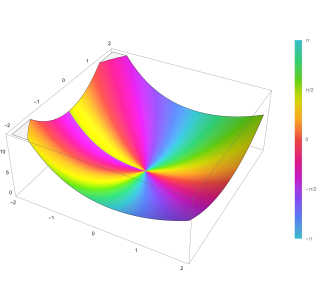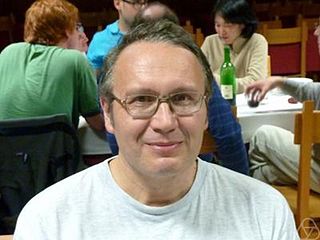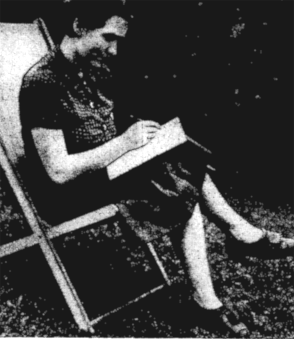Related Research Articles

In mathematics, a Möbius strip, Möbius band, or Möbius loop is a surface that can be formed by attaching the ends of a strip of paper together with a half-twist. As a mathematical object, it was discovered by Johann Benedict Listing and August Ferdinand Möbius in 1858, but it had already appeared in Roman mosaics from the third century CE. The Möbius strip is a non-orientable surface, meaning that within it one cannot consistently distinguish clockwise from counterclockwise turns. Every non-orientable surface contains a Möbius strip.

Harold Scott MacDonald "Donald" Coxeter was a British-Canadian geometer and mathematician. He is regarded as one of the greatest geometers of the 20th century.
John Arthur Todd was an English mathematician who specialised in geometry.

In mathematics, a knot is an embedding of the circle into three-dimensional Euclidean space, R3. Often two knots are considered equivalent if they are ambient isotopic, that is, if there exists a continuous deformation of R3 which takes one knot to the other.

In group theory, a topic in abstract algebra, the Mathieu groups are the five sporadic simple groups M11, M12, M22, M23 and M24 introduced by Mathieu. They are multiply transitive permutation groups on 11, 12, 22, 23 or 24 objects. They are the first sporadic groups to be discovered.
Vijay Kumar Patodi was an Indian mathematician who made fundamental contributions to differential geometry and topology. He was the first mathematician to apply heat equation methods to the proof of the index theorem for elliptic operators. He was a professor at Tata Institute of Fundamental Research, Mumbai (Bombay).
In mathematics, an exotic is a differentiable manifold that is homeomorphic but not diffeomorphic to the Euclidean space The first examples were found in 1982 by Michael Freedman and others, by using the contrast between Freedman's theorems about topological 4-manifolds, and Simon Donaldson's theorems about smooth 4-manifolds. There is a continuum of non-diffeomorphic differentiable structures as was shown first by Clifford Taubes.

In mathematics, a Whittaker function is a special solution of Whittaker's equation, a modified form of the confluent hypergeometric equation introduced by Whittaker (1903) to make the formulas involving the solutions more symmetric. More generally, Jacquet (1966, 1967) introduced Whittaker functions of reductive groups over local fields, where the functions studied by Whittaker are essentially the case where the local field is the real numbers and the group is SL2(R).
In mathematics, Kruskal's tree theorem states that the set of finite trees over a well-quasi-ordered set of labels is itself well-quasi-ordered under homeomorphic embedding.

In mathematics, an immersion is a differentiable function between differentiable manifolds whose differential pushforward is everywhere injective. Explicitly, f : M → N is an immersion if
Tudor Ganea was a Romanian-American mathematician, known for his work in algebraic topology, especially homotopy theory. Ganea left Communist Romania to settle in the United States in the early 1960s. He taught at the University of Washington.
Patrick du Val was a British mathematician, known for his work on algebraic geometry, differential geometry, and general relativity. The concept of Du Val singularity of an algebraic surface is named after him.
Hans Vilhem Rådström (1919–1970) was a Swedish mathematician who worked on complex analysis, continuous groups, convex sets, set-valued analysis, and game theory. From 1952, he was lektor at Stockholm University, and from 1969, he was Professor of Applied Mathematics at Linköping University.

Edward James McShane was an American mathematician noted for his advancements of the calculus of variations, integration theory, stochastic calculus, and exterior ballistics. His name is associated with the McShane–Whitney extension theorem and McShane integral. McShane was professor of mathematics at the University of Virginia, president of the American Mathematical Society, president of the Mathematical Association of America, a member of the National Science Board and a member of both the National Academy of Sciences and the American Philosophical Society.

In geometry, a quadrisecant or quadrisecant line of a space curve is a line that passes through four points of the curve. This is the largest possible number of intersections that a generic space curve can have with a line, and for such curves the quadrisecants form a discrete set of lines. Quadrisecants have been studied for curves of several types:
Peter McMullen is a British mathematician, a professor emeritus of mathematics at University College London.

Sabir Medgidovich Gusein-Zade is a Russian mathematician and a specialist in singularity theory and its applications.
In mathematics, the three-gap theorem, three-distance theorem, or Steinhaus conjecture states that if one places n points on a circle, at angles of θ, 2θ, 3θ, ... from the starting point, then there will be at most three distinct distances between pairs of points in adjacent positions around the circle. When there are three distances, the largest of the three always equals the sum of the other two. Unless θ is a rational multiple of π, there will also be at least two distinct distances.

Rosa Margaret Morris was a Welsh applied mathematician, working in potential theory and aerodynamics. When she was 23, her research and examination results made national news. In her later career, she taught at the University College of South Wales and Monmouthshire, where she co-authored a successful textbook on Mathematical Methods of Physics and became one of the first female Heads of School of Mathematics in the United Kingdom.
Anna Maria Zdunik is a Polish mathematician. She specializes in dynamical systems, and is a professor at the University of Warsaw.
References
- ↑ James, I. M. (1958). "Embeddings of real projective spaces". Mathematical Proceedings of the Cambridge Philosophical Society . 54 (4): 555–557. doi:10.1017/S0305004100003108. MR 0096228.
- ↑ James, I. M. (1959). "Some embeddings of projective spaces". Mathematical Proceedings of the Cambridge Philosophical Society . 55 (4): 294–298. doi:10.1017/S0305004100034083. MR 0109350.